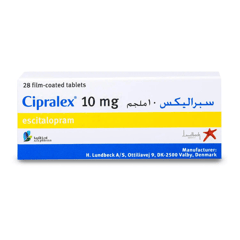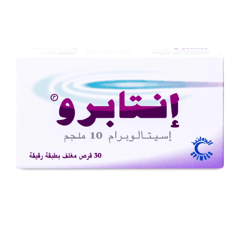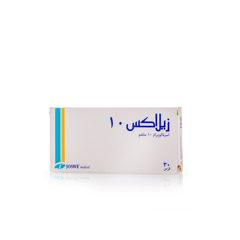Need Physician?Approval
Escitam 10 Mg 30 Film-Coated Tablets
46.60

In stock
SKU :
1011-AJ003
A valid medical prescription is required to dispense this medication
antidepressant
The generic name is Escetam
escitalopram
What is Escetam?
Escitalopram: It is a type of antidepressant drug, and belongs to the family of selective serotonin reuptake inhibitors (SSRIs) , as it works to restore the natural balance of the neurotransmitter serotonin in the brain.
Escitalopram increases the level of serotonin in the brain by inhibiting what is known as serotonin reuptake, as it binds to the serotonin reuptake pump on the membranes of nerve cells, and prevents them from doing their job (serotonin reuptake), which increases the effectiveness of serotonin.
Unlike some other types of antidepressants, escitalopram has little or no effect on dopamine and norepinephrine reuptake, and does not antagonize alpha, beta, dopamine D-2 receptors, or histamine-1 receptors.
Escetam side effects
To find out more information about the side effects resulting from the use of escitalopram, which represents the scientific name for Escetam, click here to know the side effects of Escetam.
What are the uses of Escetam?
Escitalopram is used to treat the following conditions:
Major Depressive Disorder.
Generalized anxiety disorder.
Off-label uses of escitalopram also include treating the following:
Obsessive compulsive disorder (in English: Obsessive Compulsive Disorder).
Insomnia.
PMS symptoms associated with vasoconstriction, such as hot flashes and night sweats.
Also read: Depression... a psychological disorder that can be fatal
What are the contraindications of using Escetam?
It is contraindicated to use escitalopram in the following cases:
Suffering from hypersensitivity to escitalopram, or to any of the other substances used in the manufacture of the medicine.
Concomitant use of escitalopram with other serotonergic drugs such as monoamine oxidase inhibitors increases the risk of developing serotonin syndrome, so these drugs should be separated by at least 14 days.
Concomitant use of escitalopram with linezolid , or with methylene blue , as this increases the risk of developing serotonin syndrome.
Concomitant use of escitalopram with pimozide .
What are the side effects of Escetam?
The side effects of escitalopram can be divided according to the frequency of occurrence as follows:
Common side effects
These are the side effects that have a probability of more than 10% , and they will be mentioned later.
Uncommon side effects
These are the side effects, the probability of which ranges from 1-10%, and includes the following:
Dry mouth (4-9%).
Constipation (3-6%).
Tiredness and exhaustion (2-8%).
Decreased sexual arousal (3-7%).
These are side effects that have a probability of less than 1%, and include the following:
Arthritis.
abdominal pain
abnormal bleeding
Abnormal dreams.
sensitive.
Blurred vision.
bronchitis;
chest pain
lack of appetite
lack of focus
Hemostasis problems .
vertigo.
Indigestion.
Fever.
heartburn
hot flashes
Impotence.
Irritability and nervousness.
stiffness of the jaw
lethargy or satisfactory sleepiness (in English: lethargy).
Hypertension.
Heart palpitations.
Migraine.
muscle pain
numbness
rash.
yawning.
Escitalopram may cause, in rare cases, what is known as serotonin syndrome , which is a serious health condition that requires immediate medical attention, and the possibility of its occurrence increases when escitalopram is used with other drugs that increase the level of serotonin, and its symptoms appear in the form of a rapid heartbeat. heart attack, hallucinations, incoordination of movement, severe dizziness, nausea, vomiting, severe diarrhea, muscle cramps, and others.
In rare cases , escitalopram in males may cause a prolonged erection lasting 4 hours or longer , which requires discontinuation of the drug and immediate medical attention, to avoid permanent damage to the penis.
Immediate medical attention should be sought in the event of the development of some serious side effects, such as seizures, suicidal thoughts, or symptoms of hyponatremia , or the development of vision problems such as eye pain, or changes in vision such as blurring or double Vision, swelling or redness around the eyes.
Also read: Mixed anxiety disorder and depression
What are the precautions for using Escetam?
Escitalopram has black box warnings , which are the most severe and dangerous types of warnings that can be associated with a drug, and include the following:
Use of antidepressants increases the risk of suicidal ideation in children, adolescents, and young adults (age less than 24 years), and the expected benefit should be weighed against the potential risk of using these drugs by a medical professional.
The emergence of any changes in behavior, deterioration in the diseased condition, or the development of any suicidal tendencies in patients must be carefully monitored during the first two months of starting treatment, and during the stage of adjusting the drug dose, by the specialist doctor, and by the patient’s family as well.
A deterioration in the condition, or the development of suicidal tendencies may require discontinuation of the drug.
Do not use this medicine for children under the age of 12 years.
Before starting to use escitalopram, the specialist doctor should be informed of the patient's medical history in detail, especially in the following cases:
Suffering from liver or kidney disease.
Suffering from epilepsy and convulsive seizures.
Suffering from low blood sodium level.
Suffering from heart disease or high blood pressure.
Suffering from strokes.
Suffering from blood clotting or bleeding disorders.
Having a personal or family history of bipolar disorder or manic disorder .
Having a personal or family history of suicide attempts.
Suffering from peptic ulcer.
Having a personal or family history of suffering from closed-angle glaucoma .
Suffering from addiction.
Escitalopram may cause a condition that affects the heartbeat known as QT prolongation , which in rare cases may cause serious symptoms that require immediate medical attention , such as a fast and irregular heartbeat, severe dizziness, and fainting. Certain health conditions and medications increase the risk of developing QT prolongation when using escitalopram, such as heart failure, slow heart rate, recent heart attacks, a personal or family history of QT prolongation, or sudden cardiac death.
Low levels of potassium or magnesium in the body also increase the risk of developing a prolongation of the QT interval while taking escitalopram, which may result from taking certain diuretics, or having severe diarrhea, vomiting, or sweating.
The use of escitalopram may make you feel dizzy or drowsy, so you should avoid driving, using heavy machinery, or doing any activities that require alertness if these symptoms develop.
Elderly people may be more likely to develop some of the side effects of escitalopram, such as QT prolongation, movement incoordination, bleeding, or excessive sodium loss, if they take diuretics.
Children may be more likely to develop some of the side effects of escitalopram, especially loss of appetite and weight loss, so the weight and height of the child should be monitored while using the medicine.
You should not stop using escitalopram suddenly, as this may lead to the development of unwanted withdrawal symptoms, such as nervousness and irritability, anxiety, mood disorders, headaches, sleep problems, confusion, nausea, dizziness, sweating, feeling electric tingles, and others, so it should be Consult a doctor first before stopping the use of the drug to make an appropriate schedule in which the drug is gradually stopped.
Escitalopram is classified in category C of the safety categories during pregnancy, meaning that it should be used with caution only when the expected benefit from its use outweighs the potential harms, as its use in the third trimester of pregnancy has been linked to the development of serious lung problems such as pulmonary hypertension, and other complications. Complications and withdrawal symptoms in newborns, so you should consult a specialist doctor about the possibility of stopping use escitalopramDuring pregnancy, with the need not to stop taking it without medical advice.
Escitalopram is excreted in breast milk, which may cause undesirable symptoms in nursing infants , so you should consult your doctor about options.
What are the drug interactions of Escetam?
The specialist doctor should be informed of all the medications and nutritional supplements that the patient uses before starting to use the medication, as possible drug interactions with escitalopram include the following:
Monoamine enzyme inhibitors, and pimozide, as the use of these drugs is a contraindication to the use of escitalopram, as we mentioned.
Blood thinners, as the concomitant use of blood thinners with escitalopram may increase the risk of bleeding, and these drugs include warfarin , apixaban , nonsteroidal anti-inflammatory drugs such as aspirin and ibuprofen , and others.
Migraine headache medications. Some migraine medications known as triptans act similarly to escitalopram, which increases the risk of developing side effects . These medications include sumatriptan, and others.
Other antidepressants . These drugs work similarly to escitalopram, which increases the risk of developing side effects.
Medications that affect the central nervous system , where these drugs act similarly to escitalopram, which increases the risk of developing side effects , and include zolpidem , gabapentin , and alprazolam, among others.
Cimetidine , a drug used to reduce stomach acidity, as its use with escitalopram increases the level of escitalopram in the body, and increases the risk of developing its side effects.
Diuretics, as some types of diuretics lead to a decrease in the level of sodium in the body, which increases the risk of a severe decrease in the level of sodium in the level of sodium when used with escitalopram, these drugs include furosemide (in English: Furosemide) , and hydrochlorothiazide (in English: Hydrochlorothiazide) , and spironolactone (In English: Spironolactone).
Serotonergic drugs, which include all drugs that may lead to an increase in serotonin levels in the body, which increases the risk of developing serotonin syndrome, including selective serotonin reuptake inhibitors, serotonin and noradrenaline reuptake inhibitors such as duloxetine, and venlafaxine. ) , and tricyclic antidepressants, and some opioids such as Tramadol and Fentanyl , in addition to the antianxiety buspirone , and other drugs such as lithium and amphetamine ,And St. John's wort .
Read also: psychological examination
What are the doses of Escetam and methods of use?
The appropriate doses of escitalopram are determined for each patient based on his age and health condition by the specialist doctor , so the information provided here is just general information and no treatment decision should be taken based on it.
Dosages used for escitalopram include:
For the treatment of major depressive disorder in adults: 10 mg daily for one week, then increase to 20 mg thereafter.
For the treatment of generalized anxiety disorder in adults: 10 mg daily for one week, then increase to 20 mg thereafter, with continuous monitoring, and reduce the dose to the lowest possible level in cases requiring treatment for long periods of time.
For the treatment of obsessive-compulsive disorder in adults : 10 mg per day for a week, then increase the dose to 20 mg after that, while monitoring the situation continuously, and reducing the dose to the lowest possible level in cases that require treatment for long periods of time.
For the treatment of insomnia associated with depression in adults : 5-20 mg daily for 8 weeks.
For the treatment of insomnia associated with panic disorder in adult women: 5-10 mg daily for 8 weeks.
For the treatment of PMS symptoms in adult women: 10 mg daily, may be increased to 20 mg daily after 4 weeks if symptoms are not adequately controlled.
For the treatment of major depressive disorder in adults and generalized anxiety disorder in the elderly: 10 mg daily.
For the treatment of major depressive disorder in children 12 years of age or older: 10 mg daily, which may be increased after 3 weeks to no more than 20 mg daily.
It is recommended that people with liver problems should not receive a dose higher than 10 mg daily of escitalopram.
What are the dosage forms of Escetam?
10 mg tablet, film coated
What are the storage conditions for Escetam?
Store at a temperature below 25 C, away from moisture and direct sunlight.
Would you like to speak to a doctor via text or phone?
Talk to a doctor
The name of the manufacturer of Escetam
The name of the manufacturer in Arabic is ACTAVIS LTD
The name of the manufacturer in English is ACTAVIS LTD
Sources and references
Authors
to share
Caution: This drug information does not replace a visit to a doctor or pharmacist. We do not recommend taking any medication without medical advice.
Medical news and articles
All news and articles
Articles
7 reasons for obesity and weight gain
December 6, 2022
News
Post-corona syndrome in children
December 8, 2022
Articles
Skinoren for the treatment of acne
How to use Skinoren for pills
December 6, 2022
Latest medical videos
View all medical videos
5 ways to treat knee roughness
December 7, 2022
240
Migraine treatment methods
December 7, 2022
189
How is influenza transmitted?
December 5, 2022
624
Did you find this medical content helpful?
useful
Not useful
Medication order
Alphabetical order
according to diseases
By ratings
Medical Calculators
Body mass calculator
Due date calculator
Body water calculator
Vaccination calculator
| Offer Label | Need Physician?Approval |
|---|---|
| Shipping Type | Express |
Write Your Own Review
The largest selection of casino games and sports bets at 1xbet app.






